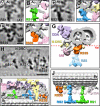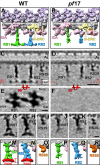Three-dimensional structure of the radial spokes reveals heterogeneity and interactions with dyneins in Chlamydomonas flagella
- PMID: 22072792
- PMCID: PMC3248890
- DOI: 10.1091/mbc.E11-08-0692
Three-dimensional structure of the radial spokes reveals heterogeneity and interactions with dyneins in Chlamydomonas flagella
Abstract
Radial spokes (RSs) play an essential role in the regulation of axonemal dynein activity and thus of ciliary and flagellar motility. However, few details are known about the complexes involved. Using cryo-electron tomography and subtomogram averaging, we visualized the three-dimensional structure of the radial spokes in Chlamydomonas flagella in unprecedented detail. Unlike many other species, Chlamydomonas has only two spokes per axonemal repeat, RS1 and RS2. Our data revealed previously uncharacterized features, including two-pronged spoke bases that facilitate docking to the doublet microtubules, and that inner dyneins connect directly to the spokes. Structures of wild type and the headless spoke mutant pf17 were compared to define the morphology and boundaries of the head, including a direct RS1-to-RS2 interaction. Although the overall structures of the spokes are very similar, we also observed some differences, corroborating recent findings about heterogeneity in the docking of RS1 and RS2. In place of a third radial spoke we found an uncharacterized, shorter electron density named "radial spoke 3 stand-in," which structurally bears no resemblance to RS1 and RS2 and is unaltered in the pf17 mutant. These findings demonstrate that radial spokes are heterogeneous in structure and may play functionally distinct roles in axoneme regulation.
Figures




References
-
- Chasey D. Further observations on the ultrastructure of cilia from Tetrahymena pyriformis. Exp Cell Res. 1972;74:471–479. - PubMed
-
- Chasey D. The three-dimensional arrangement of radial spokes in the flagella of Chlamydomonas reinhardtii. Exp Cell Res. 1974;84:374–380. - PubMed
-
- Curry AM, Rosenbaum JL. Flagellar radial spoke: a model molecular genetic system for studying organelle assembly. Cell Motil Cytoskeleton. 1993;24:224–232. - PubMed
Publication types
MeSH terms
Substances
Grants and funding
LinkOut - more resources
Full Text Sources
Other Literature Sources

